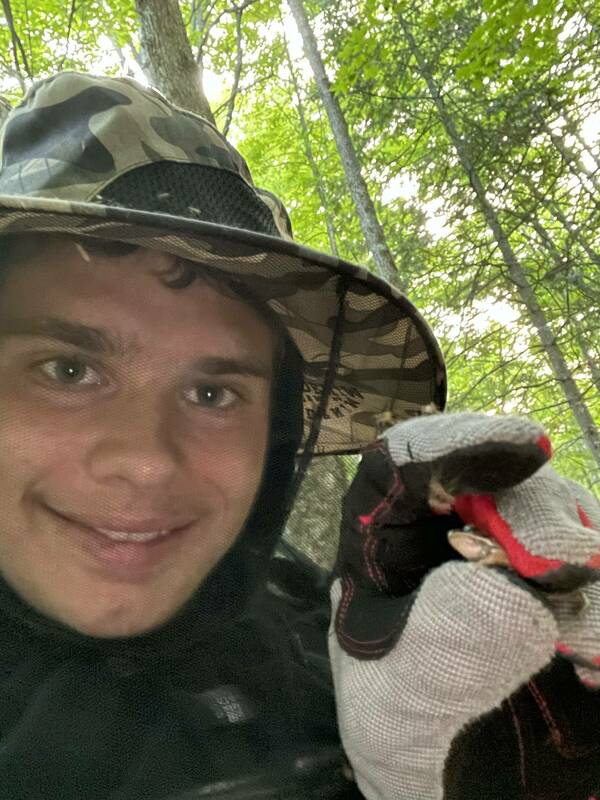Ecological Linkages Between Amphibians and Wetland Vegetation in the Upper Midwestern USA
- Student
- Samuel Bosio
- College(s)
- College of Science
- Faculty Advisor
- Gary Lamberti
- Class Year
- 2022
Abstract

Global environmental change has resulted in a variety of negative impacts on wetlands of the Midwestern United States. Amphibians play a critical role in the proper functioning of these wetlands and the ecosystem services they provide but are experiencing unprecedented declines globally. As further amphibian loss is likely despite conservation actions, I sought to understand the ecological services that will be lost with them. The effects of amphibian predation on community diversity and abundance of organisms occupying lower trophic levels are in particular need of direct study, especially in wetlands of the upper Midwest region. I addressed this knowledge gap by conducting enclosure experiments to measure the impact of amphibians on insect abundance and behavior around vernal pools in the upper Midwest, as well as indirect amphibian impacts on plant communities at the habitat scale. Insect herbivory was on average 26±13% lower in treatment plots with enhanced amphibians than in control enclosures with ambient amphibians, and the members of the herbivorous insect order Hemiptera were observed less frequently in treatment enclosures. However, impacts of amphibians on lower trophic levels were not observed in the larger habitat-scale study. Amphibians may provide localized protection to terrestrial plants by consuming herbivores, but additional research is needed to understand the relationships between vegetation and amphibian communities. I also initiated an amphibian monitoring program at Lydick Bog, a site in northern Indiana under restoration by the Shirley Heinze Land Trust, to assist in restoration monitoring. The background knowledge gained through this field study can inform management actions for Midwestern wetlands, allowing for more efficient and effective preservation of amphibians and their ecological services. Additionally, the continuation of the Lydick Bog restoration will raise community awareness of and involvement in regional ecological issues, as well as provide field research experience for students at Notre Dame.
Introduction
Amphibians are an important consumer species in aquatic and terrestrial ecosystems around the world, feeding on algae as larvae and insect populations as adults1,2. However, global amphibian decline has become an increasingly urgent issue in conservation biology over the last 25 years, as up to a third of 5,700 identified species are nearing or have suffered extinction due to invasive species, changing climates and weather patterns, and chytrid fungus3.
Understanding potential reasons for amphibian decline is important due to their role in proper ecosystem function, including keystone predation and energy transfers between aquatic and terrestrial systems. They are involved in so many natural processes that the extent of some of their ecological services is not well understood2. Information about both the ecosystem services of amphibians and reasons for reduction in their population and diversity is necessary to determine the consequences for this reduction and potential management strategies to counter it. The upper Midwest presents a unique habitat with its high frequency of aquatic habitats—including the Great Lakes and associated coastal wetlands—which causes the region to feature many habitats reliant on amphibians4. These habitats also contain sensitive and rare plant species adapted to their specific environmental conditions, and it is possible that a loss of amphibians could impact their populations by allowing herbivorous insect populations to grow while restricted by fewer predators. This project evaluated whether amphibians can cause a trophic cascade through predation pressure on insects around vernal pools in the upper peninsula of Michigan, aiming to more comprehensively inform management practices of aquatic habitats in the upper Midwest.
Another aim of this project was to use science to engage with the local community. A healthy aquatic ecosystem is likely to have an abundance and diversity of amphibians, so monitoring them throughout the year can alert land managers of ecosystem deficiencies. During a restoration effort, amphibian surveys can also be used as one of several measures of restoration progress. Lydick bog, a site being actively restored by the knowledgeable members of the Shirley Heinze Land Trust (SHLT) in St. Joseph county, has not monitored amphibian populations annually in the past. To assist evaluation of the restoration of Lydick bog, I conducted amphibian surveys and provided equipment to Lydick bog to enable future amphibian monitoring.
Endnotes
1Lamberti, G. A., Gregory, S. V, Hawkins, C. P., Wildman, R. C., Ashkenas, L. R., and Denicola, D. M. 1992. Plant-herbivore interactions in streams near Mount St Helens. Freshwater Biology, 27:237-247.
2Hocking, D. J., and Babbitt, K. J. 2014. Amphibian contributions to ecosystem services. Herpetological Conservation and Biology, 9:1–17.
3Stuart, S. N., Chanson, J. S., Cox, N. A., Young, B. E., Rodrigues, A. S. L., Fischman, D. L., & Waller, R. W. (2004). Status and trends of amphibian declines and extinctions worldwide. Science, 306, 1783–1786.
4Hecnar, S. J. (2010). Great Lakes wetlands as amphibian habitats: A review. New Pub: Michigan State University Press, 7:289–303.